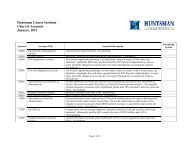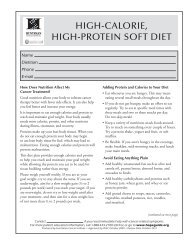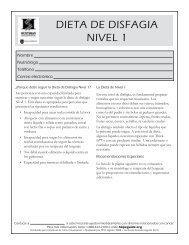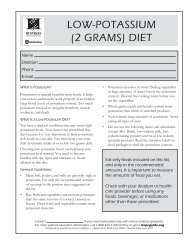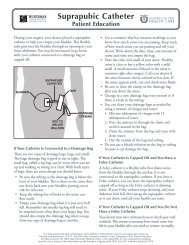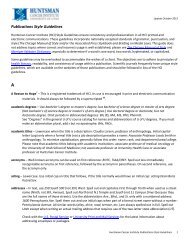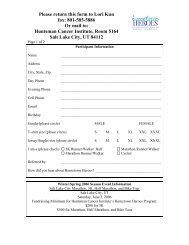Thyroglossal Duct Cyst
Thyroglossal Duct Cyst
Thyroglossal Duct Cyst
- No tags were found...
You also want an ePaper? Increase the reach of your titles
YUMPU automatically turns print PDFs into web optimized ePapers that Google loves.
<strong>Thyroglossal</strong> <strong>Duct</strong> <strong>Cyst</strong>Patient EducationWhat is a thyroglossal duct cyst?A thyroglossal duct cyst is a lump or swelling in theneck that develops from the thyroglossal duct. Thethyroglossal duct is a canal in the neck that allows thethyroid gland to form during fetal development. If thisduct does not close normally, it leaves a space that canfill with liquid or mucus (called a cyst).<strong>Thyroglossal</strong> duct cysts are most commonlydiagnosed in children; however, they can develop atany age. One symptom is the appearance of a softswelling or mass in the center of the neck. If the cystbecomes infected, it may be tender and red.How is a thyroglossal duct cyst treated?Treatment may include antibiotics to treat aninfection. A surgery called a Sistrunk proceduremay be used to remove the cyst and close thethyroglossal duct.What are the possible complications?Pain. After any surgery, some pain is normal. Whileyou are in the hospital, your health care team will dotheir best to control your pain. They will ask you oftenabout how much pain you are feeling on a scale of0-10, with 10 being the worst pain you can imagine.This information helps your health care team decidewhat medicines will best relieve your pain. They mayput pain medicine directly into your veins or give youpills, depending on what works best.When you go home, you will receive a prescription forthe same kinds of pain pills you took in the hospital.Follow the pharmacy directions for your medications,slowly tapering the amount you take as your paindecreases. Notify your surgical team if your pain doesnot decrease.Infection. Whenever there is a break in your skin,there is also a risk of infection. Good hand washingis the best and easiest way to prevent infectionfrom spreading.Wash or disinfect your hands often, and make sureyour caregivers and visitors also do so.Watch for these signs that an infection maybe starting:• Increased pain, redness, or warmth at the site ofyour surgery• Increased drainage from your surgery wound• A fever higher than 101°FIf you notice any of these signs, tell your nurse ordoctor right away.Swelling. Swelling around the surgical site causepressure on the windpipe and make it difficult tobreathe. To decrease the swelling, the surgeon willplace tubes that drain fluids to the outside at thesite of your surgery. At first, a suction deviceconnected to the tubes will help remove the fluid.Your nurses will check the amount and characterof the drained fluids often to make sure there isno infection.Swelling can also make it difficult to swallow. Itshould improve within several days after surgery.Tell your health care provider if you are not ableto tolerate liquids or if you have questions aboutyour diet.Bleeding. The neck has many blood vessels sobleeding is always a risk during neck surgery.The surgeon will place tubes in your neck to allowfluids that collect to drain away and to reduce theswelling after surgery. Your nurses will watch theamount and color of the drainage for excessbleeding. Some blood is common immediately aftersurgery, but the drainage becomes more yellow asyou heal.Pneumonia. Lying in bed too much keeps yourlungs from expanding fully. This can increase therisk of getting the lung infection called pneumoniaafter surgery. To help prevent this complication,your nurses will ask you to start walking as soonFor more patient education information, call 1-888-424-2100 toll free or go to www.huntsmancancer.orgProduced by Huntsman Cancer Institute © 2009 • Approved by PESC October 2009 • Review Date October 2012
after your surgery as it is safe. The nurses will also giveyou a device called an incentive spirometer to exerciseyour lungs in the hospital and after you go home.To use it, you breathe out as deeply as you can andbreathe in through the mouthpiece of the device. Itmeasures how much air you breathe in. After you gohome, use the device about every two hours to keepyour lungs in good shape and prevent pneumonia.Blood clots. Inactivity increases the risk that a bloodclot will form in your legs. If a clot occurs, it can movethrough the veins to your lungs. This can be deadly.To help prevent blood clots, your nurses willencourage you to get up and move around as muchas you can. While you are in the hospital, your healthcare providers may put foam boots on your legs.They inflate and deflate to keep the blood in yourleg veins moving so it cannot clot. Your doctor mayalso prescribe a blood thinner to prevent blood clotsfrom forming.For more patient education information, call 1-888-424-2100 toll free or go to www.hopeguide.orgProduced by Huntsman Cancer Institute • Approved by PESC October 2009 • Review Date October 2011




